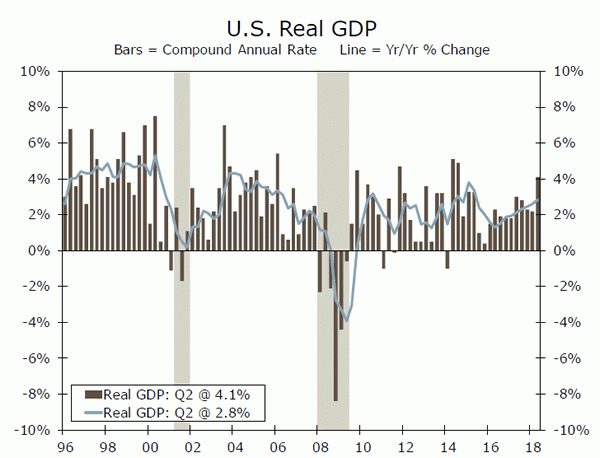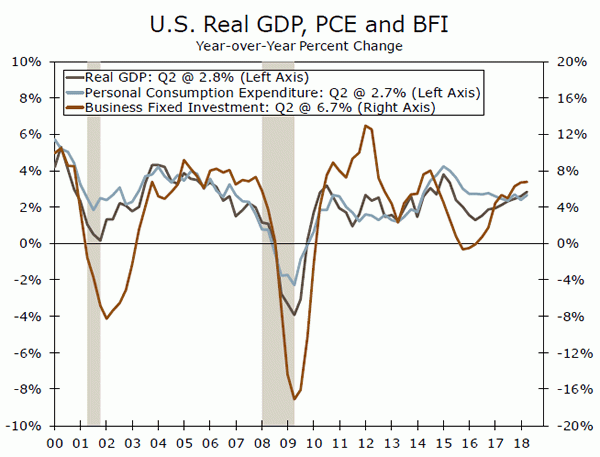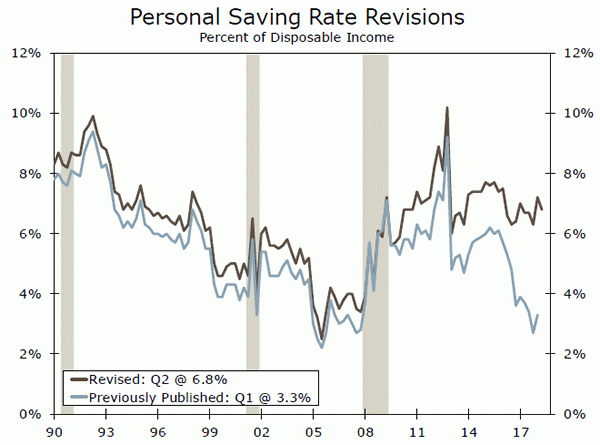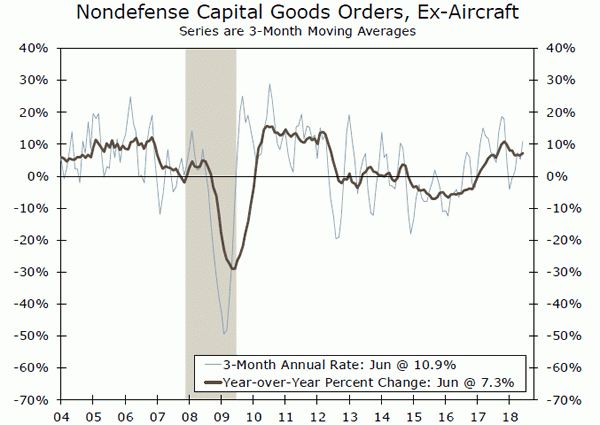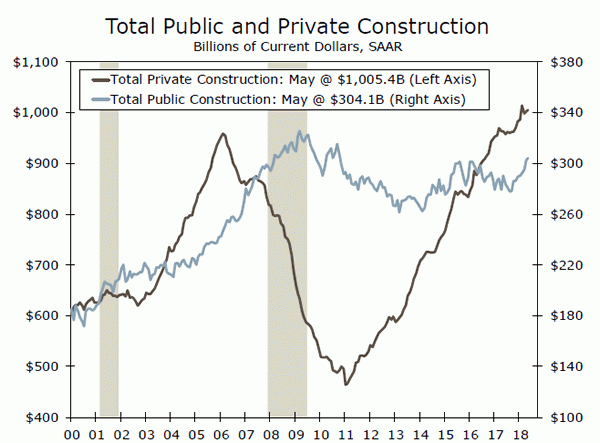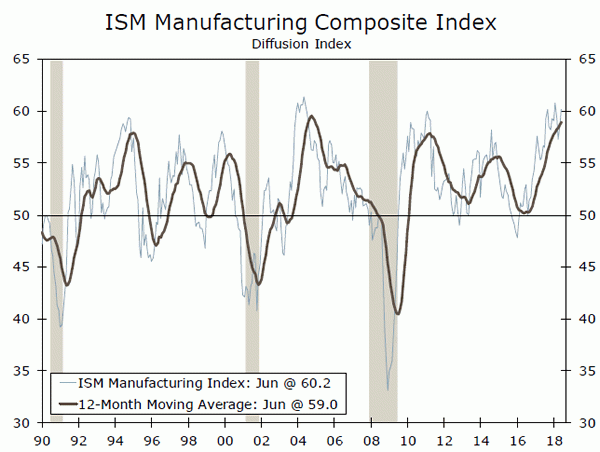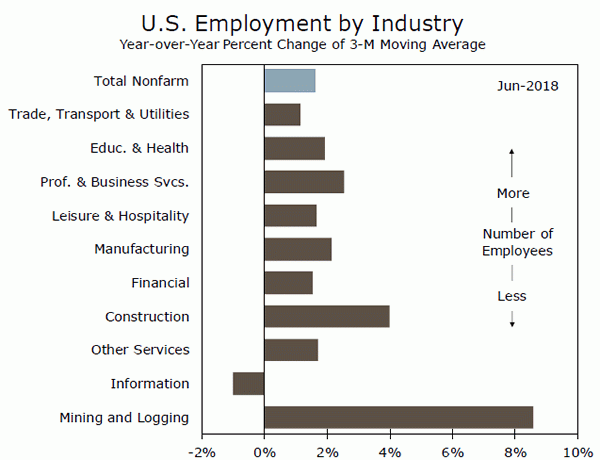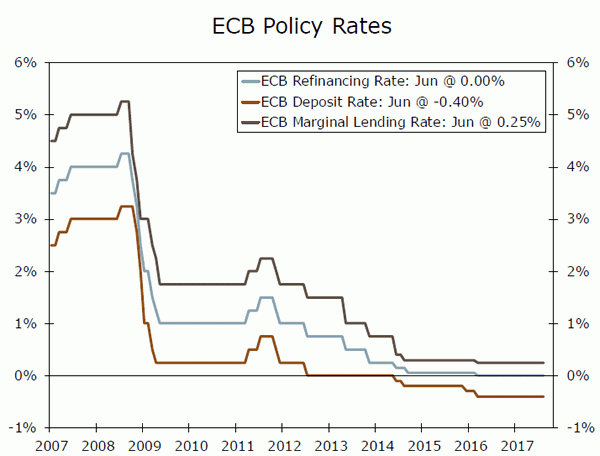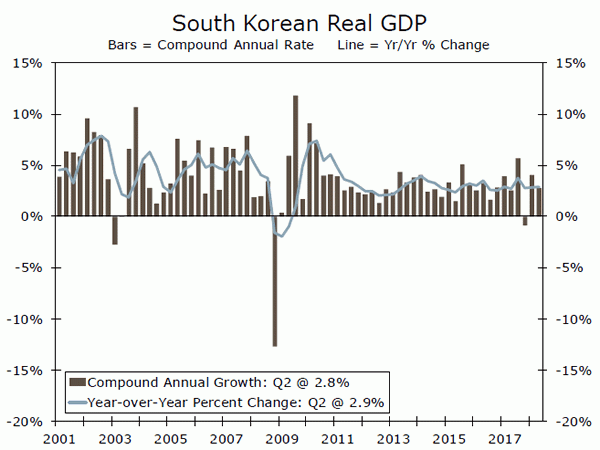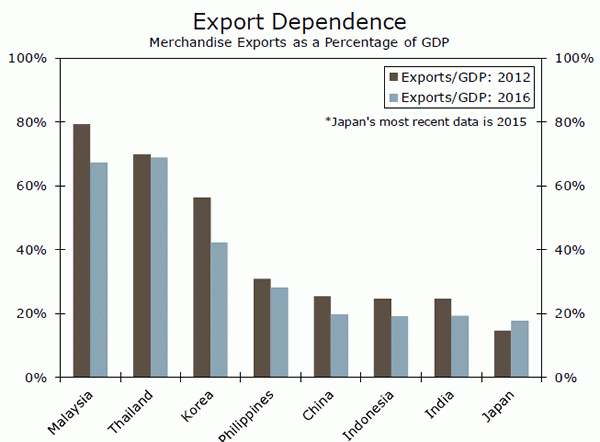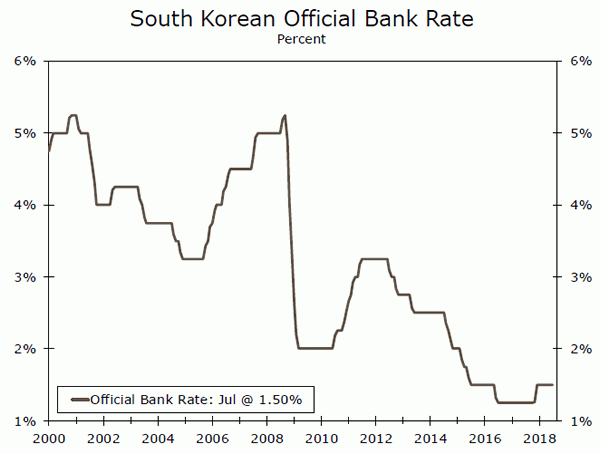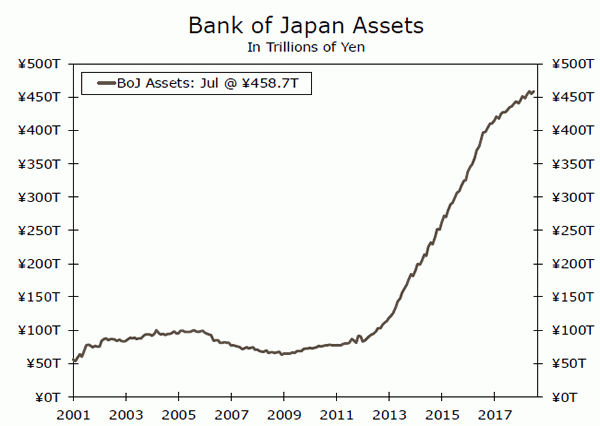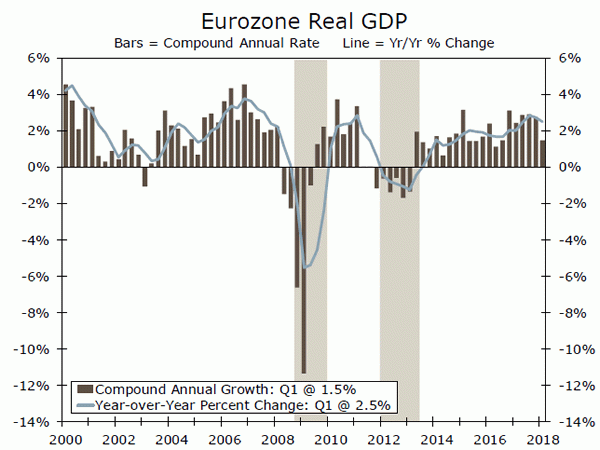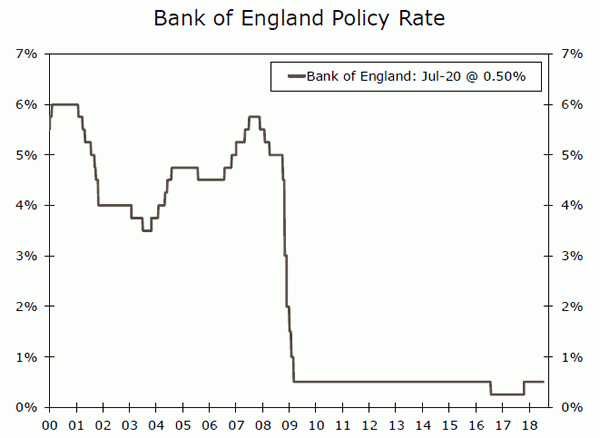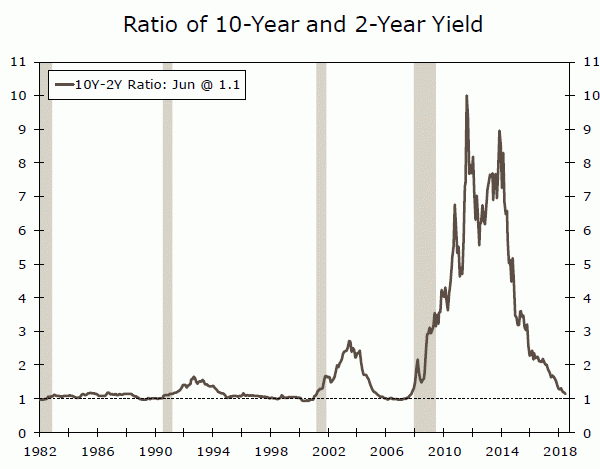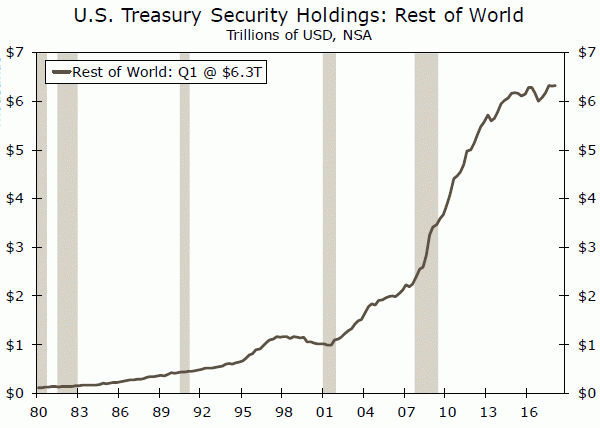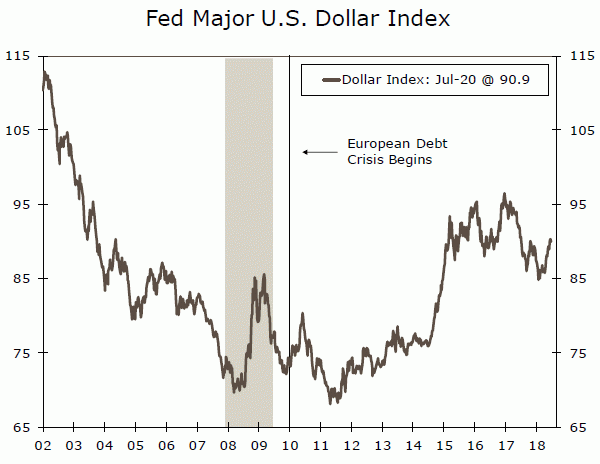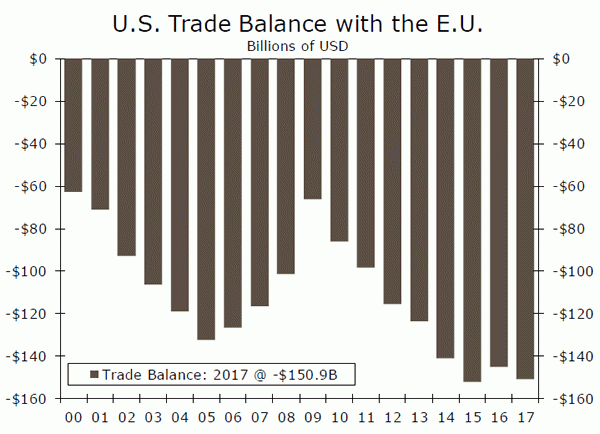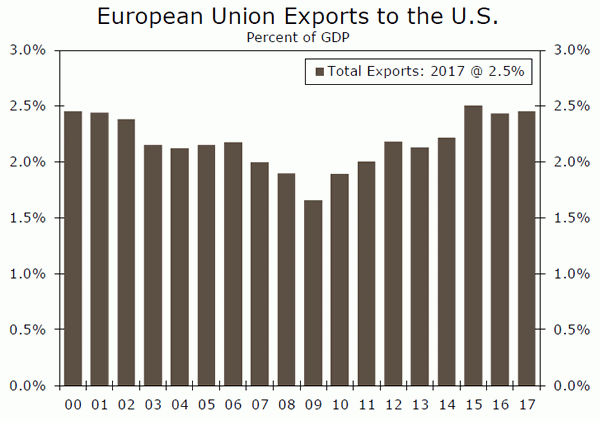U.S. Review
Upward and Onward
- Real GDP grew at a solid 4.1 percent pace during the second quarter and growth for the prior year was revised modestly higher. Real GDP is up 2.8 percent over the past year.
- The inflation data released with the GDP data show the GDP deflator rising at a 3.0 percent pace in the second quarter and climbing 2.4 percent over the past year.
- Durable goods orders came in slightly below expectations, as defense orders fell following two very strong months. Orders for commercial aircraft rose, however, and nondefense capital goods orders ended the second quarter on a strong note.
Growth Unshackled
Real GDP grew at a 4.1 percent pace during the second quarter and first quarter growth was also slightly stronger than first reported. The stronger GDP figures do not come as much of a surprise. The consensus forecast had been around 4 percent for the past few weeks and our forecast was an even higher 4.7 percent.
This past quarter’s GDP data were even more difficult to predict than usual. The second quarter data include benchmark revisions, which incorporate new methodologies and data sources. The base year was also moved from 2009 to 2012. The net result was fairly tame, however. Real GDP growth has averaged a 2.3 percent pace from the end of 2012 to the first quarter of 2018, the same as had been reported previously. The mix of growth was a little better, with business fixed investment rising at a slightly faster pace and consumer spending growing slightly less. The trade deficit, however, looks a little worse.
The critical question following the stronger second quarter figures is how sustainable is the improvement. While we doubt we will see another 4 percent quarterly gain in real GDP growth anytime soon, the economy is no longer shackled by a late-1980s’ tax system and burdensome regulations. The net result is an investment-led expansion. Real business fixed investment rose at a 9.4 percent annual rate during the first half of the year, while consumer spending grew at just a 2.2 percent pace. The strength in business fixed investment should provide the economy more resilience, by boosting productivity growth, reducing inflationary pressures and increasing the economy’s long-run potential growth rate.
The GDP deflator rose at a 3.0 percent pace during the second quarter and is up 2.4 percent year to year. Nominal GDP grew at a 7.4 percent pace and is up 5.4 percent over the past year. Real GDP measures the volume of goods and services produced in the economy, while nominal GDP measures the revenues generated across the economy. The strength in top line revenues is a big reason why private sector job growth has ramped up as much as it has in recent months and why it will likely continue to run at or above the high side of expectations going forward.
One other note from the revised GDP data is that the mix between corporate earnings and personal income is now slightly more weighted towards consumers. Moreover, the saving rate was revised significantly higher from 3.4 percent in 2017 to 6.7 percent. The saving rate averaged a slightly higher 7.0 percent during the first half of this year, reflecting tax reform.
Durable goods orders ended the second quarter on a strong note. While the headline number came in below expectations, the underlying data were strong. Overall new orders rose 1.0 percent in June. That gain, however, was held back by an 11.6 percent drop in defense orders, which followed gains of 16.7 percent in May and 9.0 percent in April. Orders for commercial aircraft and motor vehicles both rose. Orders for nondefense capital goods, excluding aircraft, which lead the business fixed investment component of real GDP and rose 0.6 percent in June and at a 10.9 percent pace during the second quarter.
U.S. Outlook
Construction Spending • Wednesday
Construction spending rose 0.4 percent in May, below expectations. Nonetheless, construction outlays were up a solid 4.3 percent yearto- date. So far in 2018, the residential component has led growth. We expect residential construction to continue on an upward path, as new home construction rises to meet unmet housing demand. However, high construction costs and labor shortages remain a challenge, and are preventing some projects from moving forward.
Public construction spending rose 0.7 percent in May, above the 0.3 percent private-sector gain. This development is notable given prior weakness. On a nominal dollar basis, public outlays are only just back above their level in early 2016. However, average spending over the past three months is up a healthy 5.1 percent year-over-year. Public-sector revenue growth has strengthened in recent quarters, which is helping to support construction spending.
Previous: 0.4% Wells Fargo: 0.3% Consensus: 0.3% (Month-over-Month)
ISM Manufacturing • Wednesday
The ISM manufacturing index came in at a solid 60.2 in June, up from 58.7 in May. Both the production and employment components were strong. The ISM has strengthened considerable since 2016, at the same time as industrial production growth has recovered from an energy-led decline in 2015-2016. While gains in the ISM have significantly outpaced production growth in terms of magnitude, the two series are still generally moving together directionally, and both support a positive outlook for the manufacturing sector.
We are looking to the ISM for information about changes in input costs and how these are impacting manufacturing supply chains. In addition to the headline index and component break-outs, the ISM release includes qualitative observations from survey respondents. We will be reading the comment section of the June report for more color on the effect of labor shortages and tariffs on manufacturers, and for early indications of wage and inflation pressure.
Previous: 60.2 Wells Fargo: 59.0 Consensus: 59.2
Employment • Friday
Payrolls increased 213,000 in June, just above the three-month average of 211,000. The diffusion index rose to 65.5 for private industries, indicating broad-based growth across sectors of the economy. Strong employment gains along with growth in aggregate hours worked (2.1 change, year over year, in June) is consistent with continued growth in personal income and consumption.
The unemployment rate ticked up slightly to 4.0 percent in May, as just over 600,000 workers joined the labor force. This pushed the participation rate up to 62.9 percent and ended a three-month slide in the participation rate for prime-age workers. Looking ahead, whether the current rate of employment gains can be sustained longterm depends on how many more workers on the sidelines can be convinced to join the labor force. Employers are facing increasing difficulty in filling open positions, which could put limits on the volume of hiring.
Previous: 213,000 Wells Fargo: 195,000 Consensus: 185,000
Global Review
Can I Put You On Hold?
- Amid a perceived thaw in international trade tensions this week, the European Central Bank (ECB) left most of the wording of its press release unchanged with no adjustment to forward guidance. The ECB will end its quantitative easing program at the end of the year, and will keep rates on hold through the summer of 2019.
- After a mixed second quarter GDP report in South Korea, that nation’s central bank has to weigh rising pressure to normalize monetary policy against its vulnerability to global trade.
South Korea as Yardstick for Measuring Trade Tension
In the early days of the coal industry, miners would bring a caged canary into the mine with them because, if the air were contaminated by methane or carbon monoxide, the bird would fall ill or die before levels became dangerous to the miners themselves.
As worries mount about an incipient trade war, countries that are particularly reliant on exports can offer clues about the prospect for how trade is weighing on economic growth. One example of such a country is South Korea, where trade tensions are a major source of uncertainty as total exports as a share of GDP are more than 40 percent.
South Korea’s economy grew at an annualized rate of 2.8 percent in the second quarter, which was a bit slower than the growth rate in the prior quarter. Despite slowing on a sequential basis, the year-over-year rate picked up slightly to 2.9 percent, and perhaps more to the point, net exports offered a bigger boost to the headline growth rate than any other category.
Before we declare the world safe from the perils of a slowdown in trade, it bears noting that the boost from net exports actually has more to do with slowing imports (down 10.0 percent at an annualized rate) than a surge in exports (which actually slowed substantially from the prior period and only grew at a 3.2 percent clip). For another data point, consider Singapore, an even more export-reliant economy, where growth slowed in the second quarter as well.
Other Areas of Growth and Outlook for Bank of Korea
Business investment slowed in South Korea in the second quarter after a strong Q1, but other than that all major categories were in expansion mode during the period.
Consumer spending advanced at 1.7 percent annualized rate and inventories increased a bit more than they did in the first quarter, resulting in a slight boost to headline growth.
At its most recent policy meeting in July, the Bank of Korea held its policy rate steady and downgraded its 2018 growth projection to 2.9 percent from 3.0 percent previously, citing corporate earnings and trade tensions as causes for the adjustment. Our own forecast for full year 2018 GDP growth in Korea is 2.7 percent.
With inflation in check and unemployment still somewhat high for structural reasons, economic conditions are not yet completely supportive of less policy accommodation. But that did not prevent one policymaker from dissenting at the July meeting, an indication that there is at least some pressure to hike rates as many other central banks are on a path toward normalization.
Although our baseline expectation is that the BoK will not raise rates at its next meeting on August 31, there is a case to be made that a hike is in the offing. The sole dissent in July came from Lee Il-houng, who as it happens was a sole dissent in October of last year (also favoring a hike), before the BoK went ahead with a 25 basis point hike the following month. In our view, the worries about global trade offset the less-than-compelling case to raise rates. Should those tensions abate, the odds of a hike go up.
Global Outlook
Bank of Japan Policy Meeting • Tuesday
Recent policy meetings at the Bank of Japan (BoJ) have been more or less uneventful because very few market participants have looked for the BoJ to change policy. However, there is a high degree of attention on the upcoming policy meeting. Japanese bond yields shot higher this week on speculation that the BoJ Policy Board may make changes to its current policy of “yield curve control,” in which the BoJ buys bonds in an effort to keep the yield on the 10-year Japanese government bond “around 0 percent.” Although we think it is premature for the BoJ to make a policy shift at this time, we will be watching the outcome of the meeting closely.
The BoJ policy meeting should be the highlight of the week, but it will occur in the midst of the usual end-of-month barrage of monthly Japanese economic data including June readings on retail sales, industrial production, unemployment and housing starts.
Previous: -0.10% Wells Fargo: -0.10% Consensus: -0.10% (Policy Rate)
Eurozone GDP • Tuesday
The Eurozone enjoyed its strongest annual average growth rate in ten years in 2017. However, GDP growth slipped in Q1-2018 and the consensus forecast anticipates that growth remained relatively lackluster in Q2. Should we be worried? Probably not. Most indicators suggest that the expansion in the Eurozone remains intact. However, the economy is simply not growing as strongly as it was last year. The GDP data will offer some more detailed insights into the current state of the macro-economy in the euro area.
Also of interest next week will be the “flash” estimates of overall CPI inflation and core inflation in July. The overall rate of CPI inflation in the Eurozone is currently running at the ECB’s target of “below, but close to, 2 percent.” However, the core rate of inflation is only 0.9 percent at present. Until the core rate of inflation rises on a sustained basis, the ECB likely will be hesitant to remove policy accommodation.
Previous: 0.4% Consensus: 0.5% (Not Annualized)
Bank of England Policy Meeting • Thursday
The Monetary Policy Committee (MPC) at the Bank of England (BoE) holds a regularly scheduled policy meeting on Thursday, and we look for the MPC to raise its main policy rate from 0.50 percent to 0.75 percent. Some recent soft economic data and lower-thanexpected inflation readings have some market participants questioning whether the MPC will actually pull the trigger. However, the MPC has publicly stated that rates eventually need to rise from their historic lows. In our view, the outlook for the economy is sanguine enough to encourage at least two MPC members to join the three other members who voted for a rate hike at the last policy meeting in June.
There are data releases scheduled for the money supply, house prices and consumer confidence, but the BoE policy meeting should be the highlight of the week in British financial markets. Previous: 0.50% Wells Fargo: 0.75% Consensus: 0.75%
Point of View
Interest Rate Watch
A Case of Mistaken Identity
A recent article cited that the Federal Reserve was taking a risky path to ignore the trend toward an inverted yield curve (top graph) since the same pattern preceded the 2007 recession.
However, we know that the appearance of a flatter/inverted yield curve in the present economy misrepresents the economic reality of the Treasury market yesterday.
Appearances are Deceiving
While the mathematics of the yield curve maybe obvious, the economic background is quite different. First and foremost is that global demand for U.S. Treasury debt has ballooned beyond the free market atmosphere of pre-2007. Central banks around the world hold more Treasury debt and private institutions demand Treasury debt as Tier 1 capital. As illustrated in the middle graph, the ramp up in the global holdings of Treasury debt since the Great Recession signals that the fundamentals that shape the yield curve have shifted. Moreover, much of the buying, such as the Fed’s, represents a non-market pricing demand for U.S. Treasury debt.
As central banks and private banks demand Treasury debt for policy and regulatory reasons, the market signal from the yield curve becomes distorted.
Win-Win on the Treasury Bet
Foreign investors in the U.S. Treasury market have also benefitted in recent years from the appreciation of the dollar (bottom graph). Foreign investors have sought Treasuries as a safe-haven given the problems of the Euro. They have also increased demand for the dollar.
Interactions between financial markets have been a central focus of our interest rate watch essays. The relationship is not always (in fact seldom is) linear but must be respected by investors. Moreover, both rates and the dollar have feedback effects on the economy. These interactions are essential to assess in any interest rate forecast. Over the last five years, we have registered betterthan- consensus forecasts for the ten-year Treasury rate, no doubt in part to our assessment of these interactions.
Credit Market Insights
Beige Book: Growth in Loan Demand
The Federal Reserve’s most recent Beige Book reported moderate or modest economic growth across the twelve districts, and credit conditions appear to be broadly stable throughout the economy. There were moderate increases in overall loan demand, and districts such as New York and Kansas City highlighted increased demand for mortgages. Other districts also mentioned a modest rise in the number of mortgages, but raised concern over the low inventory of homes for sale restraining further growth. New homes completed in inventory are currently at historic lows, so although demand for mortgages is increasing, the recent decline in mortgage applications suggests supply has yet to meet demand.
Rising mortgage demand comes as overall household debt is also increasing, up 3.8 percent year-over-year in Q1. The mortgage delinquency rate, however, continues to trend lower, and at 1.2 percent in Q1 is the lowest rate since Q3-2006. The Beige Book also confirms that delinquency rates declined slightly or were largely unchanged. Rising incomes and a solid overall economic landscape have likely positioned most borrowers to better manage housing debt. Mortgage debt as a percent of income has also declined, in sync with the trend of lower delinquency rates.
Although some districts noted rising interest rates as a possible risk to consumers meeting loan payments in the second half of the year, the Beige Book still depicts a solid overall credit market.
Topic of the Week
Trade Tensions with the E.U. Soften this Week
Earlier this week, President Trump and European Commission President Juncker reached a tentative trade deal in which the U.S. and European Union (E.U.) would work toward removing trade barriers and avoid implementing further tariffs on each other’s exports. Trade tensions had risen significantly since early March, when the Trump administration announced tariffs on imports of steel and aluminum for most trading partners. Tensions escalated further in early June when President Trump announced the possibility of tariffs on E.U. auto exports to the U.S., in further response to a widening global trade deficit, in this case with the E.U. (top chart).
Tit-for-tat retaliation since that time has totaled up to more than $50 billion in additional tariffs on U.S. exports, with the E.U. specifically retaliating with tariffs on $2.3 billion of U.S. goods implemented on June 22. While developments this week suggest that a trade war has been avoided for now, we take this opportunity to examine the implications of a possible breakdown in trade negotiations between the U.S. and E.U.
Although talks this week support the removal of trade barriers, the steel and aluminum tariffs that took effect on July 1 still remain in place. In 2017, the U.S. imported roughly $1.3 billion and $6 billion, respectively, in aluminum and steel products from the E.U. In a $17 trillion-sized economy, the current tariffs are not that extensive in size. The proposed auto tariffs would represent a small share for Europe, as E.U. auto exports to the U.S. were only roughly $50 billion in 2017.
In our view, even if trade tensions deteriorated markedly and a full-blown trade war did appear on the horizon, the impact on the overall E.U. economy would probably not be catastrophic. In 2017, total E.U. exports to the U.S. totaled roughly 2.5 percent of GDP, a relatively small number (bottom chart). A full-blown trade war would need to involve tariffs on a wider variety of goods to have a more meaningful effect. For now, trade watchers can take a deep breath.




